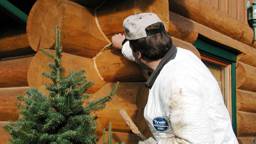
Have you ever noticed how some cabins look as if they time-traveled from the pioneer days? Some may be genuine relics that have survived the years, while others may be built new but appear old. There are many architectural details that make them look like pieces of living history, but chinking – the contrasting, textured sealant between each log – often plays a large role.
High-quality sealants help older cabins last for generations and give newer ones the rustic good looks and protection that will let them carry their historic styles far into the future. But when it comes to the sealant between logs, many people think of chinking as “log caulk.” Log caulk and log chinking are often used interchangeably, but these sealants are completely different. In fact, you should never, ever caulk a log home.
Caulking vs. Chinking
Caulk typically comes from a tube or caulking gun and is used to fill a small crack or seal edges along windows, sinks, and bathtubs. This material is designed to be squeezed out in small amounts, then blend in and disappear. Caulks are completely waterproof, easy to apply, and easy to clean up. Today, there is an overwhelming selection of caulks including waterborne, oil-based, and silicone. Prices range from $2 for an 11 oz. tube to $26 for the same size.There are three main reasons why you don’t want to use a general caulk on a log cabin:
- Caulk is impenetrable. Wood is an organic material and internal moisture is an inherent quality of any log. A caulk will trap moisture, which leads to mold, rot, and unsightly stains.
- Caulk is not engineered to adhere to wood. Some turn hard and develop a cracked, “alligator” skin or they just separate from the wood entirely. In these scenarios, the sealant has failed, and water will get underneath leading to rot and stains. When that happens, even more water can penetrate the log walls and the rotted gaps are a haven for insects.
- Caulk is a low-quality product. Despite the spectrum of price points, caulks are essentially a bottom-line resin, effective for a very narrow set of purposes. This does not include sealing your prized log home.
Unlike caulk, which tends to be smooth and glossy, chinking has dimensional texture that complements wood’s organic surface. Historically, chinking materials were made from what was regionally available. In Northern Europe, they used a special moss that did not cause log rot. Other places mixed horsehair or grass with mud or clay. Even today, it’s possible to purchase “log caulk” that has sand mixed with it to approximate a desirable rustic texture. None of these are known for their effectiveness.
In addition to texture, chinking, the kind of sealant a log cabin needs and deserves, has four distinct qualities that sets it apart from caulk.
- Log Home chinking must be breathable to let moisture escape the wood, while preventing new moisture from entering.
- Log Home chinking must have elastic qualities so it can move with wood’s daily and seasonal expansion and contraction.
- Log Home chinking must stick to the gap between the logs, even for log homes where the chinking remains invisible.
- Log Home chinking must resist the weather’s relentless tests — snow, rain, heat, and ice.

Chinking Superpower
Not only do our log sealants excel in the qualities that a high-performance chinking must possess, but we’ve devised a special formula with a distinct property. Our chinking sealants are thixotropic. A non-thixotropic sealant is prone to slumping and blistering. This requires having to reapply the sealant and hope the same issues don’t happen a second time.
Our thixotropic sealants stay exactly where the applicator leaves it making them easier to apply with accuracy. In fact, we’ve spent years perfecting our formula to find the ideal balance between viscosity and thixotropic abilities. Our sealants can be easily pumped, squeezed, and applied. Professionals love our thixotropic sealants because they can get the job done right the first time.
We offer three types of sealants to accommodate different types of log home styles. Perma-Chink, our original elastic log home chinking, is designed for log gaps sized 1-inch or larger. Energy Seal has a more refined texture for log gaps less than 1-inch. Finally, Woodsman is a smooth, lightly textured, trowellable and paintable log sealant that goes between stacked logs with no gaps. Woodsman can be easily applied to anything and painted over for an invisible finish.
All our sealant products come in an array of rich, earthy colors to compliment any log home and work as an extra-strong, protective system with our wood stains and finishes. Perma-Chink lets your log home be permanently beautiful for your permanent enjoyment.
Follow along! Join Perma-Chink Systems, Inc. in this exclusive Ask the Expert series to get answers to all your top questions about staining, sealing, maintenance and more!
Sponsored by Perma-Chink Systems, Inc.









